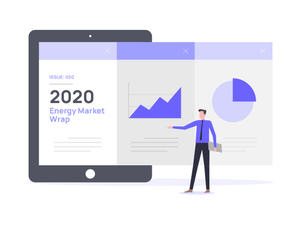It is a clear under-statement to say 2020 was an unprecedented year! The year 2020 had so many unparalleled events and the National Electricity Market and associated gas markets were no exception. The year began with the unprecedented bushfire season and then COVID struck, causing a long-lasting impact.
Below is a snapshot of the key highlights from our comprehensive 2020 Annual Market Report:
Power Spot Prices
- Average annual spot prices were the lowest for many years, although using the price sensitivity from AEMO, prices could have easily been softer
- QLD and SA had the lowest average annual price since 2011, TAS the lowest since 2014 and NSW & VIC the lowest since 2016
- Average annual prices ranged from QLD ($41.22/MWh) to NSW ($59.89/MWh)
- The frequency of negative half hour prices surged and set new records
- Intraday prices continue to re-shape, causing daytime prices to soften with greater volatility in evening peak prices, while overnight prices increased
- AGL continues to set the spot price most often and NSW generators passed QLD generators as the dominant price setter
Environmental Sector
- Latest GreenPower sales increased, thereby reversing the trend of the previous decade of sales decreasing year-on-year. Future GreenPower sales are expected to increase due to lower Large Generation Certificate prices, and strengthening consumer sustainability drive
- Large Generation Certificate (LGC) spot prices showed volatility during the year, but ended about the same level
- 'Old' hydro power stations exceeded their long-term average generation and thereby earnt significant LGCs for the third year in a row
- Forward LGC prices for years beyond 2020 are lower, but rallied throughout the year
- Small-scale Technology Certificate prices were stable
- NSW and VIC energy efficiency certificate prices rallied
Generation Sector
- The number of Lack of Reserve Notices (LOR1) was the highest since 2017 showing the grid was under greater stress. The wheel above maps the timing of LOR1 events throughout the year and by mousing-over each dot will show the number of cases and Regions affected
- Almost 2,000MW of renewable capacity came online with solar farms representing 55% of the capacity, plus almost an additional 400MW of roof-top Solar PV systems
- Corporate Power Purchase Agreements set a record in 2020
- Gas and hydro generation market share shrunk, while renewable generation including Solar PV increased
- Baseload outages for 2020 increased
- Generator price offers shifted greater capacity to lower price bands, leading to lower spot prices
- Wind farm and solar farm average dispatched prices decreased faster than the overall annual average price, with results varying by State and technology. As the proportion of intermittent generation increases, so is the discount
- Like-for-like wind energy fell, as did NSW like-for-like solar energy
- NSW, SA and QLD had an average wind profile better matching demand than VIC and TAS
- Victorian wind farms had the highest capacity factors, while QLD and NSW solar farms topped the solar ranking
- Forced renewable curtailed energy increased, but as a proportion, wind increased and solar decreased
- TAS water storages are comfortable, while Snowy Hydro's Lake Eucumbene is well below the long-term average
- Across the NEM, there is now 11,120MW of roof-top Solar PV capacity across 2.26m systems, but the payback for these systems may be extended due to lower market prices and lower future feed-in rates
Gas Market
- Gas spot prices were the lowest in 5-years at all major hubs
- Annual time-weighted average gas prices were the lowest in Brisbane, while Adelaide had the highest
- Gas and power prices remain highly correlated, although when analysed monthly, there were outliers
- LNG exports from Gladstone set a record in December, and set an annual record despite the COVID slump experienced mid-year
Financial Market Sector
- The volume weighted average forward swap price traded for 2020 had the highest premium above the actual spot price in history; the chart compares the 2020 premiums with the average premiums since 2010 for swaps, and from 2016 for caps
- The $300/MWh cap payouts were well below the volume weighted traded price in all States, except for NSW. By selecting Caps on the drop-down for the above chart, it is evident that the cap payouts premium for QLD, Vic and SA were similar to long-term averages
- The forward years of 2021 to 2024 fell during 2020 and by year-end, NSW had the strongest price level (~$56/MWh), and QLD the lowest (~$43/MWh)
Ancillary Services
- Frequency and Control costs increased by about 60% to $350m, stepping up significantly compared to the last 3-years
- The 6 second raise services trebled (i.e. arresting a major frequency drop)
- SA represented about 40% of all FCAS costs, doubling from 2019 levels
- NSW had the next largest FCAS cost increase
Emissions and Climate
- Emissions from power generation fell by almost 6% in 2020
- The decrease in emissions was due to less Sent-Out Energy and lower emissions intensity
- NSW and QLD were the largest contributors to electricity emissions but also contributed to the greatest reduction in emissions during 2020. VIC showed a slight reduction in emissions from the previous year. SA and TAS are the lowest emissions intensive States by a substantial amount
- The year had the highest average daily maximum temperature throughout most of the country, except for SA
- The number of days when the maximum daily Capital City temperature exceeded 35 degrees was the lowest since 2012
- The Cooling Degree Days was also the lowest since 2012, and in contrast, the Heating Degree Days was the highest since 2015
Our comprehensive 2020 Annual Market Report provides insights of market developments, industry trends and observations in a concise manner spread over 100 pages. The report is delivered as an online service for registered users.
By subscribing to our 2020 Annual Market Report, you will also be entitled to 3 months of our Monthly Market Report. Our fee is for an organisation and therefore entitles all registered readers from the same organisation to access the reports for the same fee of $1,500 including GST.
Our Monthly Market Reports are available for $500 per month for each organisation, or $5,000 for an annual subscription which includes our Annual Market Report.
The fees may be paid online using a credit card, or a tax invoice will be issued for payment within 14 days.
If you are a small organisation with only a casual interest in the energy market, or an individual, then please contact us as we may be able to accommodate an alternative fee.





